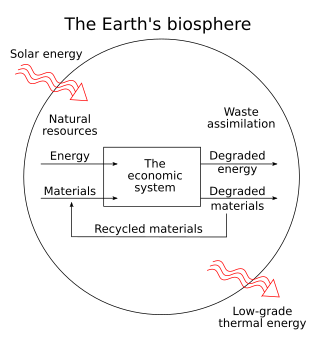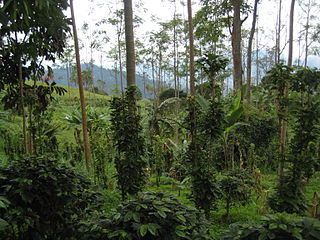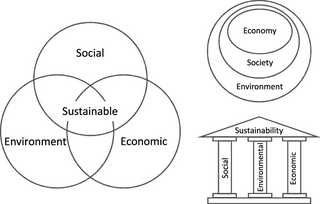Related Research Articles

Natural capital is the world's stock of natural resources, which includes geology, soils, air, water and all living organisms. Some natural capital assets provide people with free goods and services, often called ecosystem services. All of these underpin our economy and society, and thus make human life possible.

Land use is an umbrella term to describe what happens on a parcel of land. It concerns the benefits derived from using the land, and also the land management actions that humans carry out there. The following categories are used for land use: forest land, cropland, grassland, wetlands, settlements and other lands. The way humans use land, and how land use is changing, has many impacts on the environment. Effects of land use choices and changes by humans include for example urban sprawl, soil erosion, soil degradation, land degradation and desertification. Land use and land management practices have a major impact on natural resources including water, soil, nutrients, plants and animals.

Human ecology is an interdisciplinary and transdisciplinary study of the relationship between humans and their natural, social, and built environments. The philosophy and study of human ecology has a diffuse history with advancements in ecology, geography, sociology, psychology, anthropology, zoology, epidemiology, public health, and home economics, among others.

Ecological economics, bioeconomics, ecolonomy, eco-economics, or ecol-econ is both a transdisciplinary and an interdisciplinary field of academic research addressing the interdependence and coevolution of human economies and natural ecosystems, both intertemporally and spatially. By treating the economy as a subsystem of Earth's larger ecosystem, and by emphasizing the preservation of natural capital, the field of ecological economics is differentiated from environmental economics, which is the mainstream economic analysis of the environment. One survey of German economists found that ecological and environmental economics are different schools of economic thought, with ecological economists emphasizing strong sustainability and rejecting the proposition that physical (human-made) capital can substitute for natural capital.

Sustainable agriculture is farming in sustainable ways meeting society's present food and textile needs, without compromising the ability for current or future generations to meet their needs. It can be based on an understanding of ecosystem services. There are many methods to increase the sustainability of agriculture. When developing agriculture within sustainable food systems, it is important to develop flexible business processes and farming practices. Agriculture has an enormous environmental footprint, playing a significant role in causing climate change, water scarcity, water pollution, land degradation, deforestation and other processes; it is simultaneously causing environmental changes and being impacted by these changes. Sustainable agriculture consists of environment friendly methods of farming that allow the production of crops or livestock without causing damage to human or natural systems. It involves preventing adverse effects on soil, water, biodiversity, and surrounding or downstream resources, as well as to those working or living on the farm or in neighboring areas. Elements of sustainable agriculture can include permaculture, agroforestry, mixed farming, multiple cropping, and crop rotation.
The ecological footprint measures human demand on natural capital, i.e. the quantity of nature it takes to support people and their economies. It tracks human demand on nature through an ecological accounting system. The accounts contrast the biologically productive area people use to satisfy their consumption to the biologically productive area available within a region, nation, or the world (biocapacity). Biocapacity is the productive area that can regenerate what people demand from nature. Therefore, the metric is a measure of human impact on the environment. As Ecological Footprint accounts measure to what extent human activities operate within the means of our planet, they are a central metric for sustainability.

Ecosystem services are the various benefits that humans derive from healthy ecosystems. These ecosystems, when functioning well, offer such things as provision of food, natural pollination of crops, clean air and water, decomposition of wastes, or flood control. Ecosystem services are grouped into four broad categories of services. There are provisioning services, such as the production of food and water. Regulating services, such as the control of climate and disease. Supporting services, such as nutrient cycles and oxygen production. And finally there are cultural services, such as spiritual and recreational benefits. Evaluations of ecosystem services may include assigning an economic value to them.
Ecological indicators are used to communicate information about ecosystems and the impact human activity has on ecosystems to groups such as the public or government policy makers. Ecosystems are complex and ecological indicators can help describe them in simpler terms that can be understood and used by non-scientists to make management decisions. For example, the number of different beetle taxa found in a field can be used as an indicator of biodiversity.

DPSIR is a causal framework used to describe the interactions between society and the environment. It seeks to analyze and assess environmental problems by bringing together various scientific disciplines, environmental managers, and stakeholders, and solve them by incorporating sustainable development. First, the indicators are categorized into "drivers" which put "pressures" in the "state" of the system, which in turn results in certain "impacts" that will lead to various "responses" to maintain or recover the system under consideration. It is followed by the organization of available data, and suggestion of procedures to collect missing data for future analysis. Since its formulation in the late 1990s, it has been widely adopted by international organizations for ecosystem-based study in various fields like biodiversity, soil erosion, and groundwater depletion and contamination. In recent times, the framework has been used in combination with other analytical methods and models, to compensate for its shortcomings. It is employed to evaluate environmental changes in ecosystems, identify the social and economic pressures on a system, predict potential challenges and improve management practices. The flexibility and general applicability of the framework make it a resilient tool that can be applied in social, economic, and institutional domains as well.
Degrowth is an academic and social movement critical of the concept of growth in gross domestic product as a measure of human and economic development. The idea of degrowth is based on ideas and research from economic anthropology, ecological economics, environmental sciences, and development studies. It argues that modern capitalism's unitary focus on growth causes widespread ecological damage and is unnecessary for the further increase of human living standards. Degrowth theory has been met with both academic acclaim and considerable criticism.

Sustainability is a social goal for people to co-exist on Earth over a long period of time. Definitions of this term are disputed and have varied with literature, context, and time. Sustainability usually has three dimensions : environmental, economic, and social. Many definitions emphasize the environmental dimension. This can include addressing key environmental problems, including climate change and biodiversity loss. The idea of sustainability can guide decisions at the global, national, organizational, and individual levels. A related concept is that of sustainable development, and the terms are often used to mean the same thing. UNESCO distinguishes the two like this: "Sustainability is often thought of as a long-term goal, while sustainable development refers to the many processes and pathways to achieve it."

Environmental issues are disruptions in the usual function of ecosystems. Further, these issues can be caused by humans or they can be natural. These issues are considered serious when the ecosystem cannot recover in the present situation, and catastrophic if the ecosystem is projected to certainly collapse.

Planetary boundaries are a framework to describe limits to the impacts of human activities on the Earth system. Beyond these limits, the environment may not be able to self-regulate anymore. This would mean the Earth system would leave the period of stability of the Holocene, in which human society developed. The framework is based on scientific evidence that human actions, especially those of industrialized societies since the Industrial Revolution, have become the main driver of global environmental change. According to the framework, "transgressing one or more planetary boundaries may be deleterious or even catastrophic due to the risk of crossing thresholds that will trigger non-linear, abrupt environmental change within continental-scale to planetary-scale systems."
The biocapacity or biological capacity of an ecosystem is an estimate of its production of certain biological materials such as natural resources, and its absorption and filtering of other materials such as carbon dioxide from the atmosphere.

Erle Christopher Ellis is an American environmental scientist. Ellis's work investigates the causes and consequences of long-term ecological changes caused by humans at local to global scales, including those related to the Anthropocene. As of 2015 he is a professor of Geography and Environmental Systems at the University of Maryland, Baltimore County where he directs the Laboratory for Anthroecology.
Agricultural expansion describes the growth of agricultural land especially in the 20th and 21st centuries.

Ann M. Bartuska is an ecologist and biologist. She is a senior advisor at Resources for the Future and a former Deputy Under Secretary for Research, Education, and Economics (REE) at the United States Department of Agriculture and former USDA Chief Scientist.
Xuemei Bai (白雪梅) is a Distinguished Professor of Urban Environment and Human Ecology at the Australian National University. She was the winner of the 2018 Volvo Environmental Prize, and is the winner of the KIEL Global Economy Prize 2021. She is an elected fellow of the Academy of the Social Sciences in Australia and an ARC Laureate Fellow (2023-). Bai is a commissioner of the Earth Commission, leading a group on methods of cross-scale translation from planetary limits to local actors. She has been named as one of the World’s 100 Most Influential People in Climate Change Policy in 2019 and 2021.
Land change science refers to the interdisciplinary study of changes in climate, land use, and land cover. Land change science specifically seeks to evaluate patterns, processes, and consequences in changes in land use and cover over time. The purpose of land change science is to contribute to existing knowledge of climate change and to the development of sustainable resource management and land use policy. The field is informed by a number of related disciplines, such as remote sensing, landscape ecology, and political ecology, and uses a broad range of methods to evaluate the patterns and processes that underlie land cover change. Land change science addresses land use as a coupled human-environment system to understand the impacts of interconnected environmental and social issues, including deforestation and urbanization.

Ralf Seppelt is a German mathematician, academic and author. He is a professor of Landscape Ecology and Renewable Resource Economics at Martin Luther University Halle-Wittenberg, head of the Research Unit Ecosystem of the Future and the co-head of the Department of Computational Landscape Ecology at the Helmholtz Centre for Environmental Research.
References
- ↑ Verburg, Peter H; Erb, Karl-Heinz; Mertz, Ole; Espindola, Giovana (2013-10-01). "Land System Science: between global challenges and local realities". Current Opinion in Environmental Sustainability. Human settlements and industrial systems. 5 (5): 433–437. Bibcode:2013COES....5..433V. doi:10.1016/j.cosust.2013.08.001. PMC 4018982 . PMID 24851141.
- ↑ Crossman, Neville D; Bryan, Brett A; de Groot, Rudolf S; Lin, Yu-Pin; Minang, Peter A (2013-10-01). "Land science contributions to ecosystem services". Current Opinion in Environmental Sustainability. Human settlements and industrial systems. 5 (5): 509–514. Bibcode:2013COES....5..509C. doi:10.1016/j.cosust.2013.06.003.